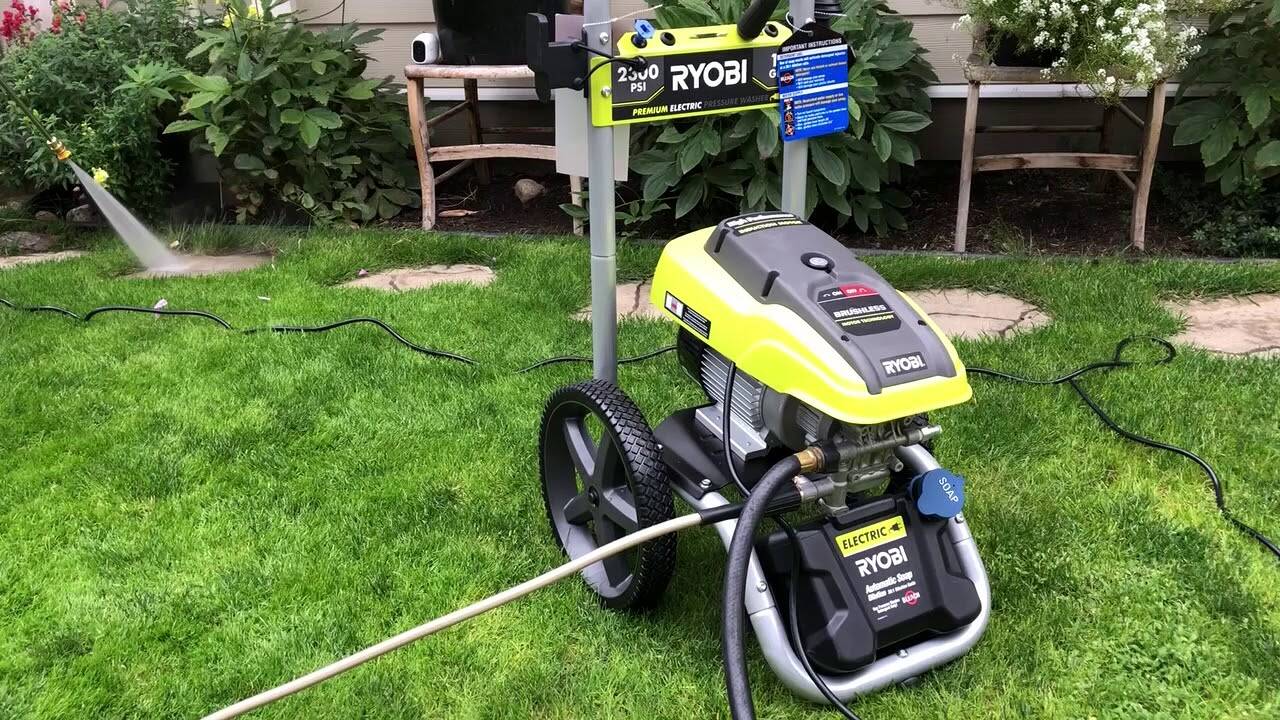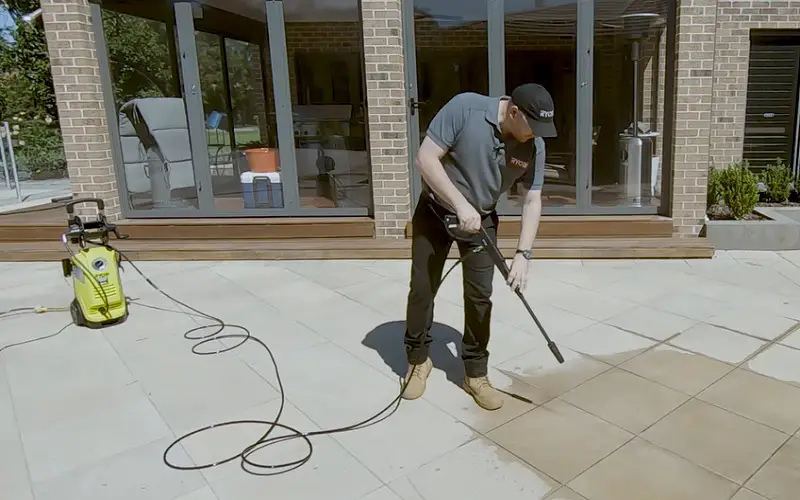To adjust pressure on a Ryobi Pressure Washer, turn the nozzle to increase or decrease pressure. Additionally, always refer to the user manual for specific instructions on adjusting pressure settings.
Ryobi Pressure Washers are versatile tools that allow you to customize the pressure according to your cleaning needs. Properly adjusting the pressure ensures efficient cleaning and helps prevent damage to surfaces.
Whether you need high pressure for tough stains or lower pressure for delicate surfaces, knowing how to adjust the pressure on your Ryobi Pressure Washer will help you achieve optimal cleaning results.
By following these simple steps, you can easily control the pressure output and tackle various cleaning tasks with ease.
Contents
Introduction To Ryobi Pressure Washers
Ryobi Pressure Washers are a great way to clean outdoor surfaces with ease. If you want to adjust the pressure on your Ryobi Pressure Washer, simply turn the nozzle to change the spray pattern and adjust the pressure accordingly.
This can help you clean various surfaces effectively. Ryobi pressure washers are versatile tools for outdoor cleaning tasks. They are durable, efficient, and easy to use.
Why Pressure Adjustment Matters
Pressure adjustment ensures optimal cleaning results and prevents damage to surfaces. It allows customization based on the cleaning task at hand.
Common Uses For Ryobi Pressure Washers
1. Cleaning outdoor furniture, decks, and driveways.
2. Prepping surfaces for painting or staining.
3. Removing stubborn dirt, grime, and mold.
Benefits of Using Ryobi Pressure Washers:
Efficient: Saves time and effort.
Versatile: Suitable for various cleaning tasks.
Effective: Provides powerful cleaning performance.
Considerations When Using a Ryobi Pressure Washer:
Safety: Follow manufacturer’s guidelines.
Surface Type: Adjust pressure accordingly.
Maintenance: Regular upkeep for longevity.

Safety First: Preparing To Adjust Pressure
Safety is paramount when it comes to using a pressure washer. Before adjusting the pressure on your Ryobi pressure washer, there are crucial steps to take to ensure your safety and the machine’s optimal performance.
By preparing responsibly, you can avoid potential hazards and make the necessary adjustments with confidence.
Protective Gear Essentials
Before starting any maintenance on your pressure washer, always wear protective gear to shield yourself from potential harm. Here are the essential items to have:
- Safety goggles to protect your eyes from debris and chemicals.
- Protective gloves to shield your hands from hot surfaces and chemicals.
- Sturdy footwear to provide stability and protect your feet from slippery surfaces.
Understanding Your Machine’s Limits
Every pressure washer model has its limits, and it’s crucial to understand them before making adjustments. Refer to the user manual to determine the maximum and minimum pressure settings for your Ryobi pressure washer. This will help you avoid overloading the machine or causing damage during the adjustment process.
Identifying Your Ryobi Model
Identifying your Ryobi pressure washer model is the first step in adjusting the pressure. Different models have unique features, so it’s essential to locate your specific model number.
Below, we’ll explore the different models and their features, as well as provide guidance on how to locate the model number for your Ryobi pressure washer.
Different Models And Their Features
Ryobi offers a range of pressure washer models, each designed to cater to various cleaning needs. From compact electric models suitable for home use to powerful gas-powered units for professional applications, Ryobi pressure washers come with a variety of features such as adjustable pressure settings, different nozzle options, and varying flow rates.
Locating The Model Number
Locating the model number of your Ryobi pressure washer is crucial for adjusting the pressure settings effectively. The model number is typically located on a label or plate affixed to the pressure washer.
It can be found on the body of the machine, often near the engine or on the frame. Refer to the user manual for specific instructions on where to find the model number for your particular Ryobi pressure washer model.
Pressure Adjustment Basics
Pressure adjustment is a crucial aspect of using a Ryobi pressure washer effectively. Understanding the basics of pressure adjustment can help you achieve optimal cleaning results while protecting the surfaces you’re cleaning.
In this guide, we’ll explore the fundamental components of a Ryobi pressure washer, how pressure is controlled, and essential tips for adjusting the pressure to suit various cleaning tasks.
Pressure Washer Components
The main components of a Ryobi pressure washer include the engine or motor, water inlet, high-pressure hose, spray gun, and nozzle. The engine or motor powers the water pump, which pressurizes the water from the inlet.
The high-pressure hose delivers pressurized water from the pump to the spray gun, where the nozzle controls the spray pattern and pressure.
How Pressure Is Controlled?
The pressure in a Ryobi pressure washer is controlled primarily by adjusting the nozzle. By twisting the nozzle, you can change the spray pattern and pressure. A narrower spray angle increases pressure, while a wider angle reduces pressure.
Additionally, some models may feature pressure adjustment settings on the pump or motor, allowing for further customization of pressure output.
Step-by-step Pressure Adjustment
Adjusting the pressure on your Ryobi pressure washer is a straightforward process that can help you tackle different cleaning tasks with ease. By following these simple steps, you can ensure that your pressure washer delivers the right amount of force for any job.
Turning Off And Disconnecting
Before adjusting the pressure on your Ryobi pressure washer, it is crucial to turn off the machine and disconnect it from the power source. This ensures your safety and prevents any accidental startup while making adjustments.
Adjusting The Pressure Regulator
The pressure regulator on your Ryobi pressure washer allows you to control the output pressure. To adjust the pressure, locate the regulator knob on the machine and turn it clockwise to increase the pressure or counterclockwise to decrease it. Make gradual adjustments and test the pressure after each change to achieve the desired level.
Testing The Pressure
Once you have made the necessary adjustments to the pressure regulator, it’s important to test the pressure before using the pressure washer.
Connect the machine to a water source and trigger the spray gun to observe the pressure. Make further adjustments as needed until you achieve the optimal pressure for your cleaning task.
Troubleshooting Common Issues
To adjust the pressure on your Ryobi Pressure Washer, first, locate the pressure adjustment knob. Then, turn the knob clockwise to increase pressure or counterclockwise to decrease it.
Test the pressure by spraying water to ensure it’s at the desired level for optimal performance.
Low Pressure Problems
If you encounter low pressure issues with your Ryobi pressure washer, there are a few common causes to investigate:
- Check the water supply: Ensure that the water source is providing adequate pressure to the washer.
- Inspect the hose: Look for kinks, blockages, or leaks in the hose that may be restricting water flow.
- Examine the nozzle: Clean or replace the nozzle if it is clogged or damaged.
Irregular Pressure Fluctuations
When experiencing irregular pressure fluctuations, consider the following troubleshooting steps:
- Inspect the inlet filter: Clean or replace the inlet filter to ensure proper water flow to the pressure washer.
- Check for air leaks: Examine all connections and fittings for air leaks that could impact pressure consistency.
- Verify the pump: Inspect the pump for any signs of damage or wear that could affect pressure regulation.
Maintenance Tips For Optimal Performance
Optimize your Ryobi Pressure Washer by adjusting the pressure for peak performance. Follow these maintenance tips to ensure efficiency and effectiveness in your cleaning tasks. Keep your equipment in top condition for consistent and powerful results.
Maintenance Tips for Optimal Performance Regular Cleaning and Storage Regular cleaning and proper storage are crucial for maintaining your Ryobi pressure washer’s optimal performance. After each use, thoroughly clean the pressure washer to remove dirt, debris, and any residue.
Pay special attention to the nozzle, hose, and connections, ensuring they are free from blockages and damage. Store the pressure washer in a cool, dry place, away from direct sunlight and extreme temperatures. This helps prevent corrosion and damage to the internal components, prolonging the lifespan of your pressure washer.
When to Replace Parts Knowing when to replace parts is essential for keeping your Ryobi pressure washer in top condition. Inspect the hoses, nozzles, and seals regularly for signs of wear and tear. Replace any damaged or worn parts immediately to prevent leaks and loss of pressure.
Keep an eye on the pump, engine, and other mechanical components for any unusual noises or vibrations, as these may indicate the need for replacement. By proactively replacing worn parts, you can avoid costly repairs and ensure consistent performance from your pressure washer.

Expert Advice And Resources
When it comes to adjusting the pressure on your Ryobi Pressure Washer, having access to expert advice and resources can make the process much smoother.
Whether you prefer professional assistance or online tutorials and guides, there are various options available to help you achieve the desired pressure settings for your cleaning tasks.
Professional Assistance
Consulting with a professional is a reliable way to ensure the pressure adjustment on your Ryobi Pressure Washer is done correctly and safely.
Online Tutorials And Guides
Online tutorials and guides can provide step-by-step instructions on how to adjust the pressure on your Ryobi Pressure Washer, empowering you to do it yourself with confidence.
Frequently Asked Questions
Is Pressure Adjustable On Ryobi Pressure Washer?
Yes, pressure is adjustable on Ryobi pressure washers. You can easily customize the pressure according to your cleaning needs.
Can You Lower Pressure On Pressure Washer Ryobi?
Yes, you can adjust pressure on a Ryobi pressure washer by using the pressure control nozzle.
Can I Adjust The Pressure On My Pressure Washer?
Yes, most pressure washers come with adjustable pressure settings. This allows you to customize the pressure for different cleaning tasks and surfaces.
Adjusting the pressure can also help prevent damage to delicate surfaces. Always consult the user manual for specific instructions on adjusting the pressure on your pressure washer.
Why Is My Ryobi Power Washer Not Strong?
Your Ryobi power washer may not be strong due to clogged nozzle, low water pressure, or worn-out pump seals.
Conclusion
Adjusting the pressure on your Ryobi Pressure Washer is crucial for optimal performance. By following these simple steps, you can ensure efficient cleaning for various surfaces.
Remember to always consult the user manual for specific instructions. Proper pressure adjustment leads to better results and prolongs the lifespan of your equipment.

